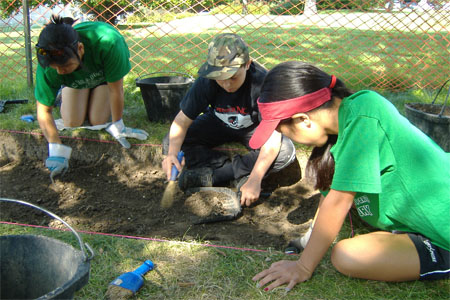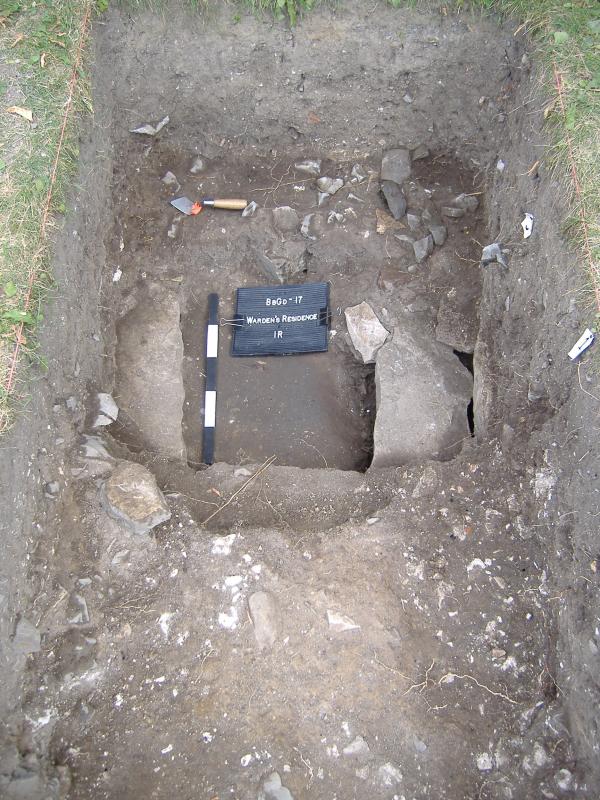 This year the “Can You Dig It?”© Summer Archaeology Program excavated once again at its original site, Canada’s Penitentiary Museum, in celebration of its 15th season. The Provincial Penitentiary of Upper Canada was constructed in 1833. Various extensive settlement and construction projects were carried out in the immediate area. Cedarhedge, the Kingston Penitentiary Warden’s residence, was completed in 1873. This building now houses Canada’s Penitentiary Museum. The excavation site is located on the upper terrace in the eastern portion of the Cedarhedge grounds. A total of six one by two metre excavation units were opened in the southeast corner of the property to continue investigations that were carried out in that area in 1996 and 1997.
This year the “Can You Dig It?”© Summer Archaeology Program excavated once again at its original site, Canada’s Penitentiary Museum, in celebration of its 15th season. The Provincial Penitentiary of Upper Canada was constructed in 1833. Various extensive settlement and construction projects were carried out in the immediate area. Cedarhedge, the Kingston Penitentiary Warden’s residence, was completed in 1873. This building now houses Canada’s Penitentiary Museum. The excavation site is located on the upper terrace in the eastern portion of the Cedarhedge grounds. A total of six one by two metre excavation units were opened in the southeast corner of the property to continue investigations that were carried out in that area in 1996 and 1997.
This location was chosen since at least two early military maps, c.1843 and c.1869, indicate that earlier buildings were once located on this specific site, while a c. 1850 map indicates a second area of development in the extreme south-east corner of the property. The purpose and usage of these buildings were investigated during the 1996 and 1997 excavations.
 The placement of the 2010 excavation units was intended to investigate the location of a limestone drain first discovered in 1997, and the shape and extent of a double stone wall cottage that was first discovered in 1997. Excavation of these units revealed many layers of landscaping fill that were used to create the terraced effect on the front lawn of the Warden’s residence. The fill was brought in from several different sources. Two of the units revealed evidence of the limestone drain. Interesting artifacts found on the site include a gilt Royal Navy Captain/Commander button with fouled anchor under a crown, that dates from c 1825-1827; a heart shaped iron tobacco tag; and various other domestic items including ceramics and smoking pipe.
The placement of the 2010 excavation units was intended to investigate the location of a limestone drain first discovered in 1997, and the shape and extent of a double stone wall cottage that was first discovered in 1997. Excavation of these units revealed many layers of landscaping fill that were used to create the terraced effect on the front lawn of the Warden’s residence. The fill was brought in from several different sources. Two of the units revealed evidence of the limestone drain. Interesting artifacts found on the site include a gilt Royal Navy Captain/Commander button with fouled anchor under a crown, that dates from c 1825-1827; a heart shaped iron tobacco tag; and various other domestic items including ceramics and smoking pipe.
Due to time constraints the majority of the units were not fully excavated to bedrock or sterile soil, but were left open, and carefully covered for the winter months so that they could be continued during the 2011 “Can You Dig It?”© program.

 This year the “Can You Dig It?”© Summer Archaeology Program excavated once again at its original site, Canada’s Penitentiary Museum, in celebration of its 15th season. The Provincial Penitentiary of Upper Canada was constructed in 1833. Various extensive settlement and construction projects were carried out in the immediate area. Cedarhedge, the Kingston Penitentiary Warden’s residence, was completed in 1873. This building now houses Canada’s Penitentiary Museum. The excavation site is located on the upper terrace in the eastern portion of the Cedarhedge grounds. A total of six one by two metre excavation units were opened in the southeast corner of the property to continue investigations that were carried out in that area in 1996 and 1997.
This year the “Can You Dig It?”© Summer Archaeology Program excavated once again at its original site, Canada’s Penitentiary Museum, in celebration of its 15th season. The Provincial Penitentiary of Upper Canada was constructed in 1833. Various extensive settlement and construction projects were carried out in the immediate area. Cedarhedge, the Kingston Penitentiary Warden’s residence, was completed in 1873. This building now houses Canada’s Penitentiary Museum. The excavation site is located on the upper terrace in the eastern portion of the Cedarhedge grounds. A total of six one by two metre excavation units were opened in the southeast corner of the property to continue investigations that were carried out in that area in 1996 and 1997. The placement of the 2010 excavation units was intended to investigate the location of a limestone drain first discovered in 1997, and the shape and extent of a double stone wall cottage that was first discovered in 1997. Excavation of these units revealed many layers of landscaping fill that were used to create the terraced effect on the front lawn of the Warden’s residence. The fill was brought in from several different sources. Two of the units revealed evidence of the limestone drain. Interesting artifacts found on the site include a gilt Royal Navy Captain/Commander button with fouled anchor under a crown, that dates from c 1825-1827; a heart shaped iron tobacco tag; and various other domestic items including ceramics and smoking pipe.
The placement of the 2010 excavation units was intended to investigate the location of a limestone drain first discovered in 1997, and the shape and extent of a double stone wall cottage that was first discovered in 1997. Excavation of these units revealed many layers of landscaping fill that were used to create the terraced effect on the front lawn of the Warden’s residence. The fill was brought in from several different sources. Two of the units revealed evidence of the limestone drain. Interesting artifacts found on the site include a gilt Royal Navy Captain/Commander button with fouled anchor under a crown, that dates from c 1825-1827; a heart shaped iron tobacco tag; and various other domestic items including ceramics and smoking pipe.